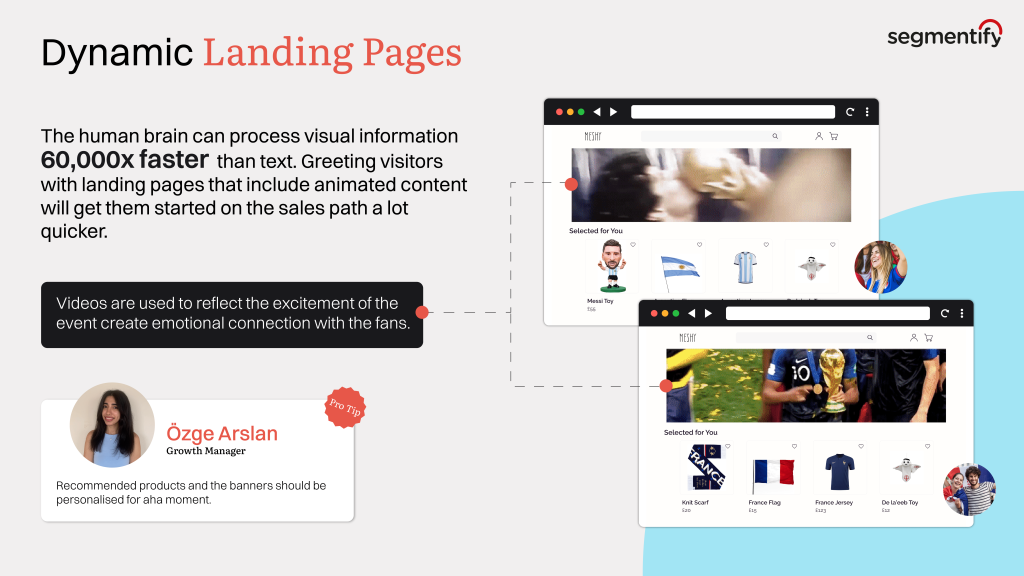Our websites use cookies. By continuing, we assume your permission to deploy cookies as detailed in our Privacy Policy.
Behavioural Segmentation: Definition, Benefits, Examples (2023)
What is behavioural segmentation? What are its benefits? And perhaps a more pressing matter, what are the must-know behavioural segmentation strategies and examples for every marketer out there?
This article will answer all of these questions swarming around your head. You just sit back and relax.
And if you have questions about customer segmentation examples or types of online customers you should know about, follow the white rabbit. 🐇
What is Behavioural Segmentation?
Behavioural segmentation divides customers and users into subgroups based on behavioural patterns and tendencies.
In other words, behavioural segmentation delves into the behavioural characteristics of users, encompassing factors such as their awareness of, attitudes toward, usage of, preferences for, and responses to a product, service, promotion, or brand.
Explore the strategic methods for gaining a deeper understanding of your customers with Customer Segmentation Playbook.
Behavioural Segmentation Benefits
- Enhanced precision in targeting: Behavioural segmentation empowers you to tap into the nuances of customer behaviour, enabling you to direct your marketing messages strategically.
- Personalised customer experiences: One size doesn’t fit anyone. You can establish a personal connection with each individual by identifying your audience’s unique needs, desires, concerns, and message preferences. This enables you to present relevant offers and suggestions that are more likely to resonate and lead to conversion.
- Cost-efficiency: Behavioural segmentation enables you to allocate your marketing budget strategically by targeting your most interested, engaged, and valuable audiences. This eliminates wasteful spending on cold leads and disinterested parties, maximising your ROI.
- Measurable results: Tracking key metrics within each behavioural segmented campaign empowers you to take informed actions and continually improve your marketing strategies. This iterative approach can lead to better results over time.
- Increases brand loyalty: Customers who feel valued and special are likelier to remain loyal to your brand. Building customer loyalty not only increases customer lifetime value but also boosts overall revenue for your business.
5 Behavioural Segmentation Examples You Should Know
Here, we delve into comprehensive insights about 5 potent behavioural segmentation examples that warrant your consideration for optimising your marketing strategy:
1. Purchasing Behaviour
Segmenting customers based on their purchasing behaviours is a widely adopted approach in behavioural segmentation.
This behavioural segmentation strategy involves categorising customers according to their buying habits and transaction histories, enabling companies to anticipate the behaviours most likely to lead to a purchase or conversion.
Behavioural segmentation based on purchasing habits can be explained in 4 distinct categories:
- Complex decision-making: Customers falling into this behavioural pattern are deeply engaged in their decision-making process due to its complexity and significance. The purchase journey tends to be lengthy and involves extensive product research. Products under consideration often exhibit substantial, distinctive differences.
- Variety-seeking: Variety-seeking behaviour emerges when customers engage in low-risk decision processes in their daily lives. The consequences of their purchase decisions have minimal impact on their daily routines, allowing room for experimentation and diverse purchasing behaviours within repetitive buying cycles.
- Dissonance reduction: This scenario resembles complex decision-making but with a twist. The decision remains essential, but the products being compared lack significant differences in their features. These products or companies are generally very similar, leading customers to typically favour the one with the lowest price.
- Habitual purchasing: Habitual behaviour typically arises from personal preferences or strong brand loyalty. The products being compared usually share similar features, and the decision-making process is not intricate or highly involved. This category often reflects customers’ consistent loyalty to a specific brand or product.
2. Spending Habits
Behavioural segmentation based on your audience’s spending habits can provide invaluable insights for enhancing your marketing campaigns’ performances. This method entails considering various aspects of customer spending behaviour:
- Shopping mode: Distinguishing between online and in-store shopping preferences.
- Promotional sensitivity: Identifying the discount seekers.
⚡️ Pro tip: Constantly targeting non-discount seekers with personalised discount campaigns would be a strategic mistake.
Let’s illustrate for clarity. You have a gamification campaign, a Spin the Wheel game, with different discount prizes in each slice. You should not waste this on non-discount seekers.
Targeting the discount-seekers with this kind of gamification campaign will get you more conversions. Because they’re always actively looking for deals.
- Payment method preference: Identifying customers’ payment method preferences.
Understanding how your customers allocate their resources, where they choose to spend, and when they do so can significantly enhance your marketing strategy.
This behavioural targeting optimisation maximises the utility of your existing resources and capital while ensuring that customer awareness and engagement remain top priorities.
3. User Status
Behavioural segmentation based on how much a user interacts with your brand, website, or app is also a great way to get to know your audience.
Understanding and catering to each user status segment’s unique needs and behaviours is crucial for a well-rounded marketing approach that maximises user engagement and satisfaction.
The most common user status segments are:
- Non-users: They have never engaged with your product or service. You should focus on educating them and generating initial interest.
- Potential users: Potential users have shown interest or are in the early stages of considering your product. You should nurture their curiosity and guide them towards conversion.
- First-time users: These are individuals who have recently started using your product or service. Your goal should be to provide an exceptional experience to ensure they become repeat users.
- Regular users: Regular users are loyal customers who frequently engage with your website and/or app. You should focus on retaining their loyalty, enhancing their experience, and encouraging continued engagement.
- Former users: Former users, or churn customers, have previously interacted with your product but are no longer active. You should identify the reasons for their departure and entice them to return.
4. Customer Journey Stage
A customer’s journey unfolds through several distinct stages, each offering valuable insights for marketers:
- Awareness: In this initial phase, customers are identified based on their initial interactions with a brand. By analysing these early interactions, you can determine which customers are potential prospects worth pursuing.
- Engagement: The engagement phase includes customers eager to learn more about the brand, its services, and its values. Segmenting customers based on their engagement levels and responses helps identify effective strategies, products, or campaigns that drive conversions and foster customer loyalty.
- Evaluation/Consideration: Following successful engagement, customers enter the critical phase of considering their purchase decisions. Breaking down this phase lets you pinpoint the paths leading to successful conversions.
- Purchase/Conversion: Segmenting users according to their purchasing behaviour enables you to measure the effectiveness of all sales channels, as discussed earlier.
- Post-purchase: A brand’s journey with the customer is incomplete even after a successful purchase. Tracking post-purchase behaviour allows you to create segments based on user actions and develop strategies to optimise after-sale loyalty efforts efficiently.
Throughout this journey, marketers gather a wealth of data, each phase characterised by unique traits such as traffic patterns, operational efficiency, and cost consumption.
Analysing this data empowers you to craft consumer-specific and journey-specific marketing strategies, ultimately boosting conversions at every stage. Moreover, it facilitates the identification of phases that require further development, enabling you to allocate budgets more effectively, tailor messages, and send notifications that resonate with customers at different stages of their journey.
5. Customer Loyalty
Behavioural segmentation based on users’ loyalty levels is a vital customer segmentation strategy.
Identifying and nurturing loyal customers is paramount as they often contribute the most substantial share of your revenue. Not only do they generate repeat business, but they also tend to increase the average order value (AOV), benefiting your bottom line.
To maximise the impact of loyalty-based customer segmentation and make other customer segments more like your loyal customers, consider integrating it with other technical approaches such as customer journey and user status.
Combining aggregated customer data from various segmentation methods can provide valuable insights into customer loyalty.
Once you’ve identified your audience’s loyalty boundaries and their specific needs, here are some considerations to enhance their progression to the next loyalty level:
- Analyse what factors contributed to their increased loyalty and at which stage of the customer journey this occurred.
- Determine the most effective ways to engage and impress your most loyal customers.
- Evaluate which aspects of your brand are compelling to loyal customers and which areas need improvement to nurture further loyalty.
Enhance Landing Page Personalisation with Dynamic Content through Segmentify
No two website visitors or app users are identical.
Segmentify’s advanced algorithms recognise and categorise visitors based on their unique behaviours and actions. Leveraging this valuable data, Segmentify utilises behavioural segments to personalise landing pages with tailored banners, products, and content carefully selected to engage and resonate with each visitor.
The ability of our algorithms to distinguish between an Argentina soccer fan and a France supporter can make all the difference in creating a meaningful user experience.
And when it comes to personalising landing pages, incorporating videos is the icing on the cake.

Consider this: The human brain processes visual information a staggering 60,000 times faster than text. By welcoming visitors with landing pages featuring personalised animated content, you initiate their journey along the sales path more swiftly.
This approach forges a stronger emotional connection with your brand, facilitating a faster and more engaging interaction.
Don’t hesitate to contact us for more information on how Segmentify can revolutionise your landing page personalisation. We’re here to answer your questions and help you tailor your marketing strategies for optimal results.
Editor’s Note: This article was originally published on September 14, 2021, and was updated for accuracy and comprehensiveness on September 7, 2023.





